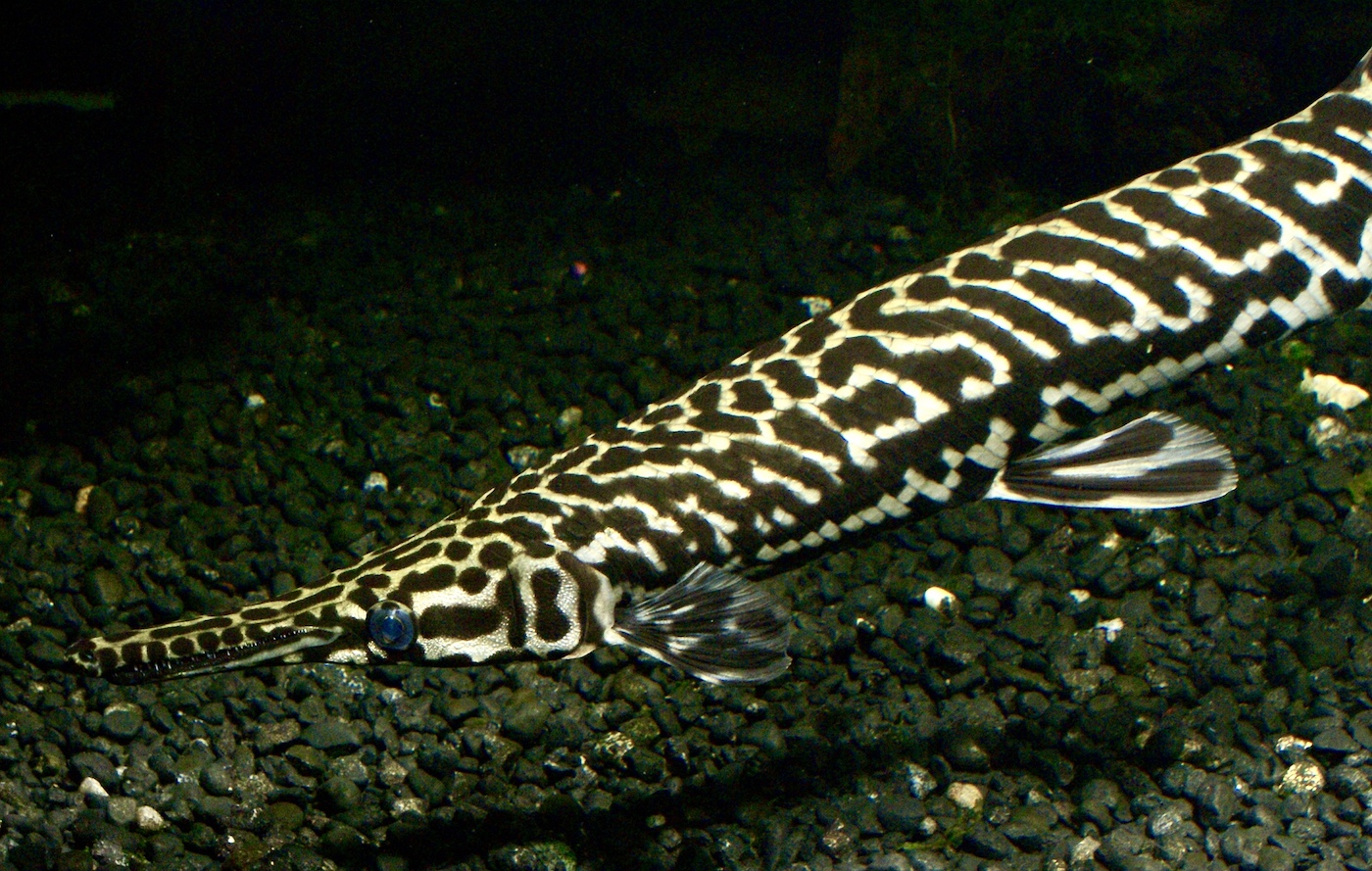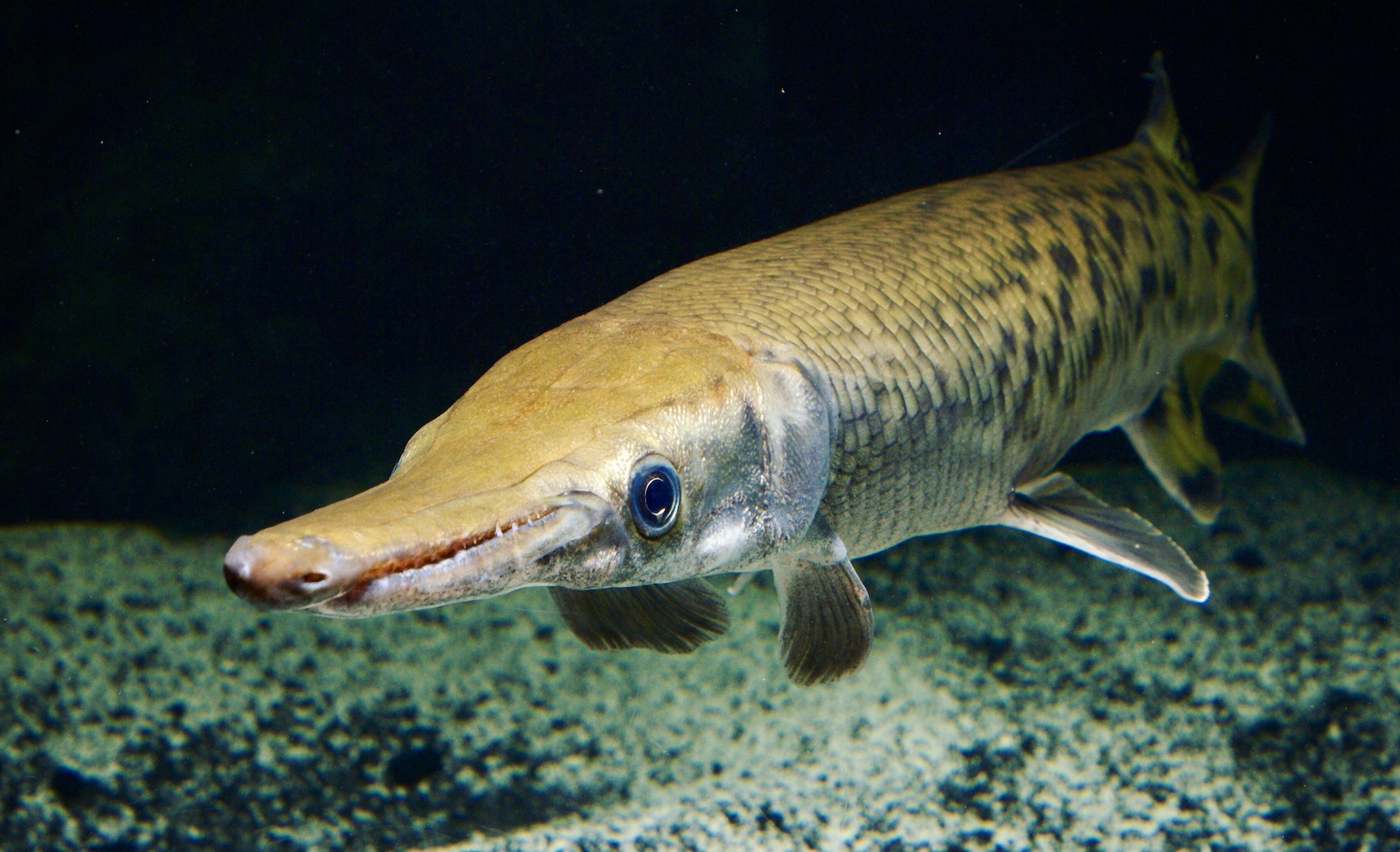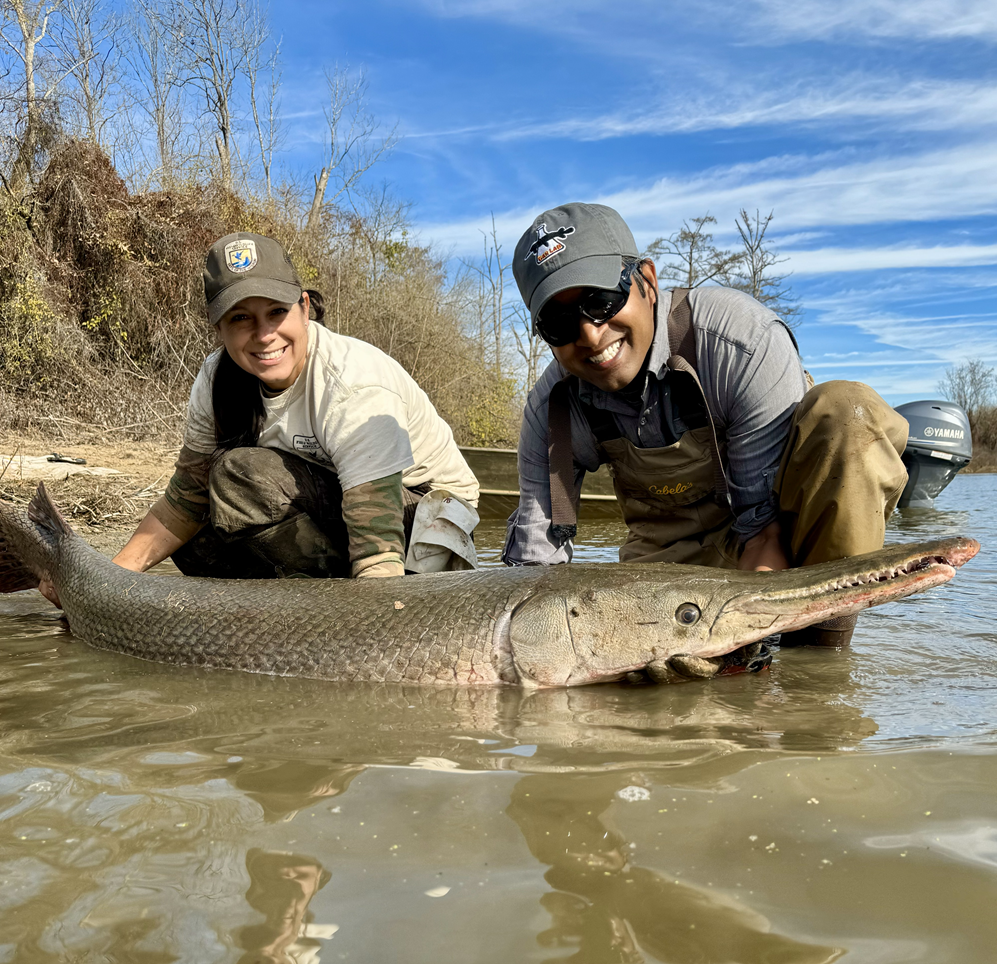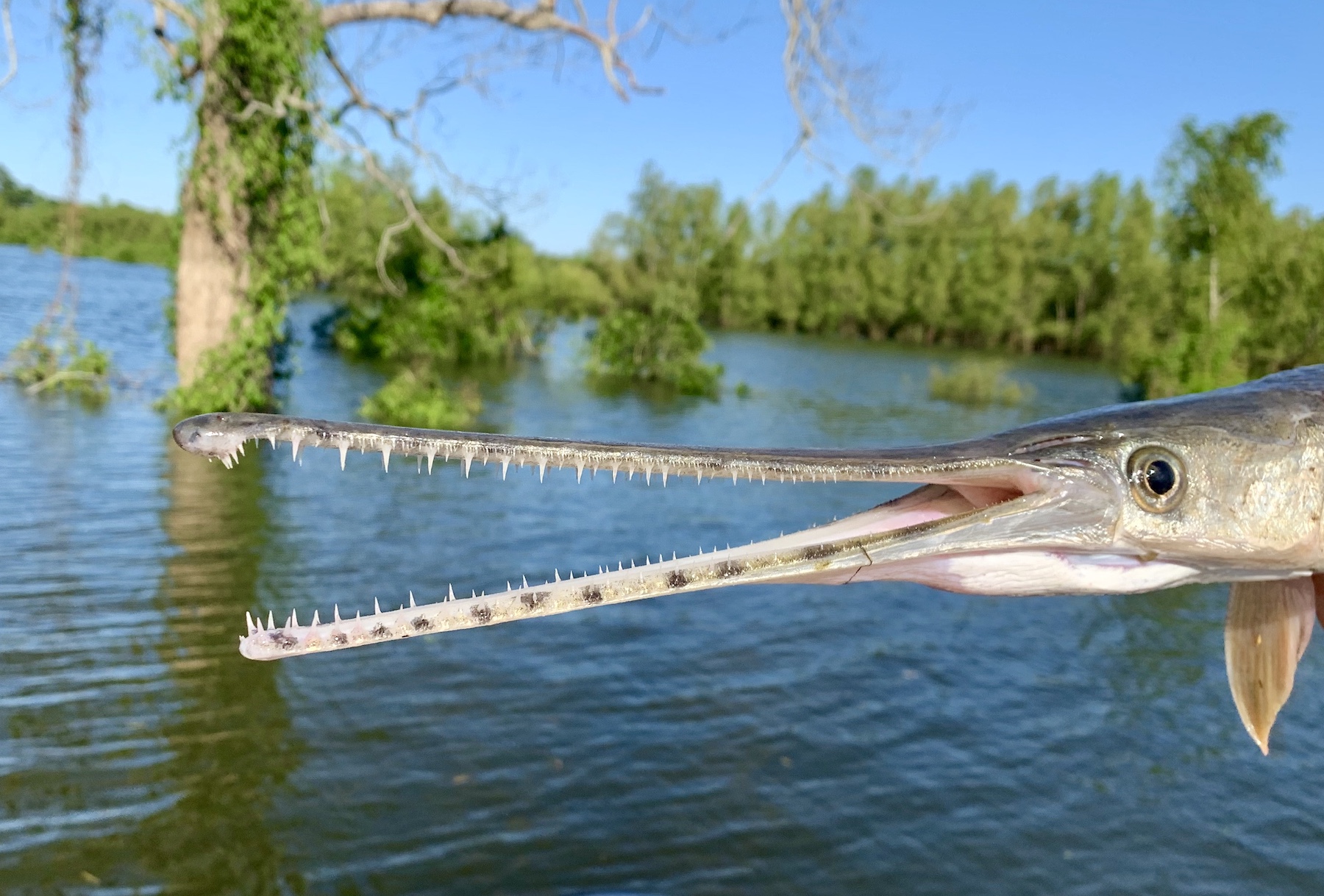A Strange-Looking Fish, Frozen In Time
17:09 minutes

The term “living fossil” has been applied to any number of animals, from sharks to turtles to the coelacanth. It’s the idea that those animals look very much the same way their species may have looked millions of years ago, with limited evolutionary change over that time.
After analyzing the genomes of many different species on that “living fossil” list, researchers report they may have found an animal that evolves more slowly than all the others—a group of fish called gar. The rate of molecular change in gar genomes is the slowest of any jawed vertebrate, the researchers say. In fact, gar genomes change so slowly that two gar species that diverged from each other over 105 million years ago can still interbreed and produce fertile offspring. In evolutionary time, that’s comparable to the distance between humans and elephants. The researchers believe that the slow rate of change in gars may be due to an exceptional ability to repair mutations and other errors in their genes.
Dr. Solomon David, assistant professor of aquatic ecology at the University of Minnesota, and Chase Brownstein, a graduate student in Yale’s department of ecology and evolutionary biology, join Ira to discuss the findings, recently reported in the journal Evolution.



Dr. Solomon David is an Assistant Professor of Aquatic Ecology at the University of Minnesota in Minneapolis, Minnesota.
Chase Brownstein is a graduate student in the Department of Ecology and Evolutionary Biology at Yale University in New Haven, Connecticut.
IRA FLATOW: This is Science Friday. I’m Ira Flatow. You’ve probably heard the term living fossil applied to any number of animals– sharks, some turtles, the coelacanth. It’s the idea that the animals look very much the same way their species may have looked millions of years ago, with limited evolutionary change over that time.
After analyzing the genomes of many different species on that living fossil list, researchers report they may have found an animal that evolves more slowly than all of them– a fish called the gar. They reported their findings in the Journal Evolution. Joining me now to talk about what they’ve learned about the gar so far are my guests, Dr. Solomon David, assistant professor of aquatic ecology, University of Minnesota in Minneapolis. Welcome back to Science Friday.
DR. SOLOMON DAVID: Thank you very much, Ira. Happy to be here.
IRA FLATOW: And Chase Brownstein, a graduate student in Yale’s Department of ecology and evolutionary biology in New Haven, Connecticut, and he is the lead author on that study I just mentioned. Welcome to Science Friday.
CHASE BROWNSTEIN: Thanks so much. Thanks again for having me.
IRA FLATOW: You’re welcome. Solomon, for our listeners who have never seen one, what is a gar? Where are they found? What do they look like? Where do they live? Give us a little summation there because they’re kind of weird looking, aren’t they?
DR. SOLOMON DAVID: They definitely are an oddball fish. When people ask what a gar looks like, I tell them to picture a crocodile or an alligator with fins instead of legs, and that’s basically what a gar is. They have this prehistoric look to them, which kind of matches this living fossil idea. They’ve got a long snout, lots of teeth. They’ve got armored scales. They’re typically found in fresh water, but they’re found from Canada all the way south to Costa Rica, and some of them can even live in saltwater for quite a long period of time.
IRA FLATOW: Hmm. So that saltwater one would be a sea-gar.
DR. SOLOMON DAVID: That’s a classic. You have to say it.
IRA FLATOW: I have to say it, so let me get it out of the way. Chase, when I think of living fossils, I think of a coelacanth, right? And you’re saying the gar is fossil-ier than that?
CHASE BROWNSTEIN: Yeah. Well, so first of all, I want to say there is a species of gar from Cuba, and my lab likes to joke that that’s the Cuban cigar. So getting the puns right out of the way.
IRA FLATOW: [LAUGHS]
CHASE BROWNSTEIN: So the coelacanth, discovered to be alive in 1936 after being known from the fossil record as a classic example of a living fossil. But what we’re showing here is that at least in some lineages, namely gars and then the sturgeons and paddlefishes actually have a molecular mechanism behind these intriguing patterns of their evolutionary history and modern diversity.
In these lineages, there is actually a very low rate of change across the genome. And as it turns out, gars and sturgeons actually have the slowest rates of change by several orders of magnitude throughout their genomes of all jawed vertebrates. So that’s animals with a backbone and a jaw.
IRA FLATOW: Wow. So how old a lineage are we talking about here? How much of a fossil is this?
CHASE BROWNSTEIN: So gars, at least the common ancestor of all living species, is about 105 million years old. So that’s actually a little over 30 million years older than Tyrannosaurus Rex.
IRA FLATOW: Wow. You’ve blown my brain on this one. This same fish, basically unchanged, has been around since before T Rex?
CHASE BROWNSTEIN: Yes. I would say virtually unchanged. So I mean, there are differences, right? I mean, these things have evolved. It’s just that they’re evolving at such a slow rate.
IRA FLATOW: Dr. David, did this surprise you, learning all of this?
DR. SOLOMON DAVID: Yeah. I think as someone who’s studied gars for 20 years, we find that gars have been doing their thing for 157 million years. So there’s a lot of catching up to do. So it was surprising, but if you look at the fossil record, you look at fossil gars, and then you look at gars that are alive today, they look very much the same.
So this was really cool to see that they were slower to change than coelacanths, and tuataras, and crocodilians. I knew there was something special about them, always thought that. But it took Chase leading the charge here to really kind of bring that science to light, which I think is really cool.
IRA FLATOW: That is cool. Part of this work involves hybrid gars, right, Solomon?
DR. SOLOMON DAVID: Yep.
IRA FLATOW: And a mix of two species, what’s going on there? Why is that significant?
DR. SOLOMON DAVID: Back in the day, those of us that kept aquarium fish noticed that there were some weird looking gars. And the fish that’s actually been in a lot of the promotion for this study is a hybrid gar that I found at a pet shop maybe 20 years ago. And we thought it was something weird. It looked like a combination of two different species– actually genera of gars. And there was a paper that came out in 2008 that so little information was available about gar hybridization that they cited the pet trade, and some website stuff that I’d posted as being sort of an initial evidence.
And they ended up showing that gars had hybridized in Shedd Aquarium in Chicago. And then reports started coming from the wild of longnose and alligator gars hybridizing in parts of Texas. So this is really kind of a building effect of noticing stuff going on in the wild, stuff going on in the aquarium trade, and then bringing that to the science, the analysis that Chase did, to see that this hybridization is actually a big deal.
IRA FLATOW: How do you get a hybrid gar?
DR. SOLOMON DAVID: Yeah, we think a lot of it is they’re spawning– some individuals happen to be spawning at the same time, and typically, this ends up being male longnose gars spawning around the same time that female alligator gars might be spawning. It could technically go in both directions, but they’re broadcast spawners. They’ll release the gametes at the same time. So if you’ve got male longnose gars kind of mixing it in with a group of alligator gars, you could have a hybrid result there. But what’s really interesting is that this is crossing genera that diverged over 100 million years ago, and I’m sure Chase could speak more to that.
IRA FLATOW: Yeah Chase, fill us in on that.
CHASE BROWNSTEIN: Yeah, absolutely. For the hybrid analysis side of the study, credit where credit is due to my amazing co-lead author, Dan MacGuigan at the University at Buffalo, who really pushed for the genetic analyses we feature in the paper. And what we had found, actually, is that the hybrid gars are not only viable– so you have this 105 million year split between the two living gars. That’s actually older than the split between you and an elephant, basically. Or it’s like, slightly older than that.
So if you can imagine that these two lineages which last shared common ancestry 105 million years ago are still able to hybridize, and not only that, but we find in this paper that there is strong evidence that the hybrids are fertile. The hybrids can reproduce. And then thirdly, that the hybrid gars, although they look distinct relative to their parents, are actually not pushing out of the range of variation we see in fossil and living gars.
So in other lineages, including the African cichlids, which are very famous, and also often kept in aquarium tanks, you actually see this pattern where hybrids between different species can actually show new patterns of anatomy, and color, and things like that. Gars actually don’t do this. So the hybrids are within that realm of variation, and that’s pretty important.
And the other thing is that they’re fertile. So this is the oldest hybrid cross among eukaryotic organisms– that’s organisms that have a nucleus where they keep their DNA, right?– ever observed in the wild. Older than any other plant lineage, older than any other animal lineage, older than any other fungi that hybridize. And it’s incredible, and we’re explaining this pattern as a consequence of this extremely slow molecular rate.
IRA FLATOW: Do we know why they have this slower rate of change?
CHASE BROWNSTEIN: Yeah. So that is actually sort of the next frontier of our research. There’s a variety of explanations that have been proposed for variation in the rates of change in the genome over millions of years– population size, how long it takes for new generations to appear, as well as age. And in other fishes that actually have faster rates, we see a high degree of variance in these features. And gars aren’t like the most special in any of those parameters.
One thing that we think might be going on, based on evidence from sturgeons and paddlefishes, is an exceptional DNA repair apparatus. When you have a mutation, right?– that occurs in a gene, one of the things that your cells do is they can actually try to repair that. They can try to reverse the change. And this process is called DNA repair. And one possibility is that gars and sturgeons might just have a really, really good DNA repair abilities, like exceptional DNA repair abilities.
DR. SOLOMON DAVID: An example I like to use is kind of imagine a perfect game of telephone where the message just doesn’t change from person, to person, to person, or from year, to year, or millions of years.
IRA FLATOW: You know, when we talk about gene damage, as you have, and gene repair, I’m thinking about cancer, right? Where genes go bad. Is there something to learn about people here, Solomon?
DR. SOLOMON DAVID: Yeah, I think so. I think from a conservation angle, there’s a bit of irony here where fish that are largely thought of as trash fish might end up turning around and being helpful to humans from a human health and medical standpoint. With a lot of the genomics work that’s being done with gars, establishing gars as a potential model organism, they’re doing that at Michigan State, colleagues Ingo Braasch, and also at Nicholls State, we’ve worked on that.
So we’re establishing gars as a sort of model organism to help improve our understanding of human evolution, human disease. And so I think there’s a lot of potential there when we think about potential transgenics. Can we identify that DNA repair mechanism– and Chase can speak to that particular gene that we think it is– and can we take that further to maybe look at how this responds in other organisms to different types of environmental stimuli, from toxins to other types of impacts.
IRA FLATOW: Chase, can you take it a little further and tell us?
CHASE BROWNSTEIN: Yeah, absolutely. So that’s I mean, kind of exactly what we plan to do. I mean, this is what my goal is, and looking at seeing if we can experimentally verify whether there are certain repair mechanisms in gars that when expressed in other species, like model organisms like the zebrafish, for example, whether they actually help these organisms survive what we call, mutagenic environments or substances. These are things that induce mutation and DNA damage.
IRA FLATOW: This is Science Friday from WNYC Studios. If you’re just joining us, we’re talking about the idea of living fossils and how one fish, the gar, might wear the living fossil crown. Solomon, if they are evolving so much more slowly, does that mean they’d be slower to adapt to some kinds of environmental change? I mean, isn’t this actually a liability? How are they able to overcome that?
DR. SOLOMON DAVID: Yeah, I think that’s a great question. And you would expect that with this low rate of evolution, that gars may not be the most adaptive. But in truth, they already are extremely adaptive. They can live in saltwater. They can live in freshwater. They range from Canada all the way down to Costa Rica.
All of the gar species can hybridize. They can hybridize across genera, hybridize across species. They have toxic eggs, armored scales. They grow to relatively large sizes. Some of them can live for over 100 years. So it’s almost like an if it ain’t broke don’t fix it situation. And they found this model that works, and they’ve stayed consistent with it for 150 million years plus.
CHASE BROWNSTEIN: You might be familiar, and listeners might be familiar with an evolutionary biologist and paleontologist named Stephen Jay Gould. In the ’70s, he published a paper called The Spandrels of San Marcos, which is one of the papers I love. It’s a great thought paper. And he cautioned people against what he called a evolutionary just so stories. In other words, the elephant got its trunk because it needed to reach for water, and the giraffe got its long neck because it needed to reach for the trees, and so on and so forth. And I think gars actually provide a really interesting example of why that’s maybe not the best way to think about evolution.
So one thing that we do as evolutionary biologists is that we tend to look at groups that have a lot of species in them. And one reason this is is because well, that’s a lot of replicates. We can sort of go through that group, and see what’s going on, and see the diversity, and you know, look and see what stories the lineage has to tell.
The problem with that approach is that it denies us a view that’s given by these species-poor living fossil lineages, if you will. What gars are saying is that they’ve, for whatever reason, happened to survive for about 100 million years. And they’ve been able to do it without drastically changing their morphology, and it seems like their genotype, their genes.
So one possibility is that it might just be the case that due to a number of historical accidents and sort of contingency, as we call it, these incredible fishes have survived. So Solomon mentioned a bunch of features of the anatomy and life history of gars that are really quite interesting and unusual. Again, they have this interesting ability to tolerate saltwater and sort of murky environments.
In 2022, I was working with a paleontologist at the Denver Museum, Tyler Lyson, and we actually described the gar that’s like five feet long. It’s a relative of the alligator gar, and it lived about 1,300 to 1,500 years after the asteroid impact that killed the dinosaurs. Actually, Tyler is incredible because he and his team collected a block of sediment from just below the gar that actually has the layer that records the asteroid impact. It’s right below the gar, and he still has that block in the museum.
IRA FLATOW: Wow.
CHASE BROWNSTEIN: But even though they’re able to tolerate these environments, and in sort of an exceptional manner that really is quite interesting, and that almost certainly probably helped them survive these kind of major cataclysms of our Earth’s history, I would caution a view that gars are like, perfectly adapted, whatever that might mean. Because that really doesn’t mean anything, and adaptation is variable depending on the context– your developmental context, how you’re growing up, whether different parts of your body plan are jiving together, and how much can change your body plan, how the environment changes, which it certainly has.
And what gars are saying in some sense is that you don’t necessarily have to be perfectly adapted, or like, drastically changing your anatomy to survive. In some respects, you know, this sort of accident question that they’ve, you know, managed to survive for how long they have is almost more intriguing because it forces us to reckon with the possibility that we might be just getting part of the story from these really species-rich, you know, adaptive radiations, if you will, of life.
Despite all of that and despite their kind of incredible evolutionary histories, which people like myself and Solomon can geek out on, they’re really not recognized in North America. And I got to say, that’s really sad. Like, gars and bowfin, in some respects, are like our, you know, lungfishes, or our kangaroos and stuff. They’re not found anywhere else, and they have this incredibly ancient evolutionary heritage.
IRA FLATOW: Wow. That is a great way to end. What a summation, because who knew? I mean, certainly not I, and a lot of people who just look at a gar and say, that’s kind of a weird looking creature. We have run out of time. I want to Thank you both, Dr. Solomon David, assistant professor of aquatic ecology at the University of Minnesota in Minneapolis, and Chase Brownstein, graduate student in Yale’s Department of ecology and evolutionary biology. Thank you for enlightening us today.
DR. SOLOMON DAVID: A gargantuan thank you for having us.
CHASE BROWNSTEIN: Yes. Thank you so much. It’s been a pleasure.
Copyright © 2024 Science Friday Initiative. All rights reserved. Science Friday transcripts are produced on a tight deadline by 3Play Media. Fidelity to the original aired/published audio or video file might vary, and text might be updated or amended in the future. For the authoritative record of Science Friday’s programming, please visit the original aired/published recording. For terms of use and more information, visit our policies pages at http://www.sciencefriday.com/about/policies/
As Science Friday’s director and senior producer, Charles Bergquist channels the chaos of a live production studio into something sounding like a radio program. Favorite topics include planetary sciences, chemistry, materials, and shiny things with blinking lights.
Ira Flatow is the founder and host of Science Friday. His green thumb has revived many an office plant at death’s door.